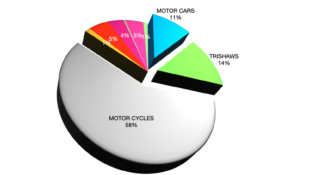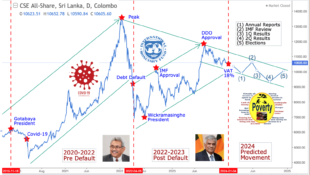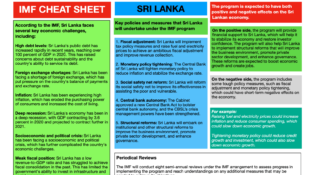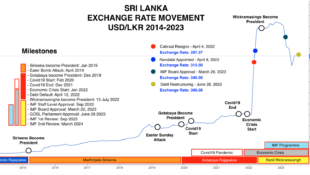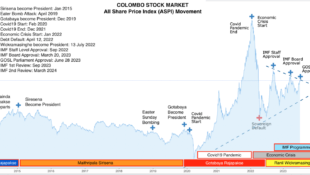Further to my previous posting The Basics of Valuing Companies,
http://forum.srilankaequity.com/t10053-the-basics-of-valuing-companies
Here I set out a basic toolkit of valuation measures. So let's start with the familiar:
P/E Ratio
The price earnings ratio (P/E) is the price of a share divided by its earnings per share (EPS). It is usually described as how many years of earnings are required to pay back the cost of buying a share, assuming no growth.
Another way of looking at the P/E ratio is that it is the reciprocal of earnings yield, which is EPS divided by the share price. If a company has a P/E of 8, its earnings yield is 12.5% (100/
The P/E ratio is a ubiquitous measure of the rating of a share, and the simplest way of comparing two companies. But it is vital to ensure that you are comparing like with like:
• P/Es can be historic (based on latest reported earnings), prospective (based on forecast earnings) or trailing twelve month. If a company has reported interim results then its trailing twelve month P/E will be based on the earnings figure in the latest interims plus the last half of the previous year;
• If companies do not have coterminous year ends (e.g. if one has a year end on 30 June and another 31 December) then you need to compare the historic P/E of one with the trailing twelve month P/E of the other;
• Reported EPS figures can be basic, diluted and adjusted, so there are as many variants of the P/E ratio; and
• It can be safer to calculate the P/E yourself, on a per share basis or on a "whole company" basis as market capitalisation divided by earnings, which gives the same result.
P/E Relative
The P/E relative is simply a company's P/E divided by the market, or sector, average P/E.
So if a company has a P/E of 10 and the sector has an average P/E of 8 then its P/E relative is 125% (10/
Dividend Yield
This is dividend per share divided by the share price. Dividend yield can also be historic, prospective or trailing twelve month, and similar cautions about comparing like with like apply.
Dividend yield is intrinsically linked to earnings yield, and hence P/E ratio, through the payout ratio, the proportion of earnings paid as dividends rather than reinvested in the company.
A company can set the level of its dividend by varying the payout ratio. So dividend yield should always be considered in the context of the dividend cover, or EPS divided by its dividend per share. This shows how comfortably a company can afford to pay its dividend. Dividend cover is the reciprocal of the payout ratio.
PEG Ratio
The PEG ratio is calculated as the P/E ratio divided by the forecast growth in earnings.
It attempts to measure how much investors are paying for the anticipated future growth, and is associated with the "growth at a reasonable price" investment style.
Sometimes it can be helpful to look at some other valuation metrics as well:
Price/Sales Ratio
This is calculated by dividing the share price by revenues per share, or dividing market cap by total revenues.
It can be very illuminating in comparing companies who are direct competitors, and is useful:
• In comparing companies with very different gearing, which distorts P/E ratios; and
• If there are no earning figures, e.g. the company has made losses or is a start-up.
Price/Book Value & Price/Tangible Assets
Price to book is calculated as share price divided by net assets per share (or market cap divided by net assets). It is especially useful in specific sectors such as valuing banks, and gives an indication of how much substance underlies a company's market valuation.
Using only tangible assets is a harsher test of how much the valuation is backed by physical assets and is a useful "make sense" check as well as being associated with certain styles of investing.
Some analysts prefer to compare ratios based on a company's enterprise value (EV), which is its market capitalisation plus its outstanding debt (or long-term debt).
EV/EBITDA
EBITDA is earnings before interest, tax, depreciation and amortisation, and is operating profit (EBIT) with depreciation and amortisation added back.
This ratio is more robust in comparing companies which have very different capital structures and/or depreciation and amortisation policies.
EV/NOPAT
NOPAT is net operating profit after tax. It equals earnings before interest payments are deducted, and so the ratio is analogous to the P/E ratio applied to debt holders and shareholders taken together.
Valuable comments are appreciated
Edited article from Investing Stratergy
Last edited by sriranga on Sun Mar 10, 2013 12:37 am; edited 1 time in total
 would enable you to enjoy an array of other services such as Member Rankings, User Groups, Own Posts & Profile, Exclusive Research, Live Chat Box etc..
would enable you to enjoy an array of other services such as Member Rankings, User Groups, Own Posts & Profile, Exclusive Research, Live Chat Box etc.. 
 Home
Home












